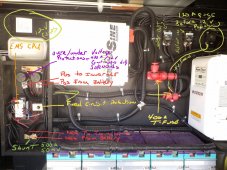RandyP
Solar Enthusiast
- Joined
- Sep 21, 2019
- Messages
- 742
New approach to setting SCC voltages for LiFePO4 battery.
I came across this You Tube channel,
'Off-Grid Garage'
and have watched several of the videos there.
I discovered this info. Its new thinking for me.
https://www.youtube.com/watch?v=6vTaCkTVl7I
Armed with this bandwidth concept between Boost/Absorb charge voltage setting and Float voltage setting and loss of solar energy when the SCC is operating in this band I went out and changed my SCC boost/absorb and float voltages to both be 13.8 v. In addition to these two changes as suggested by the video above, I changed my Boost charge return voltage to 13.8 (I am using a Renogy SCC and it requires this additional voltage setting).
The result was prenominal !
Yesterday I played with the SCC in full sun and was only able to get about 300w power thru the SCC to the battery & load. Had the boost/absorb voltage at 13.8, the float at 13.7 v and the Boost Charge return set to 13.3 v.
Today, with good sun, and the three voltage settings at 13.8 v, by varying the load on the battery, I was able to get just under 400 watts thru the SCC to the battery/load. After the battery was sufficiently discharged by increasing the load beyond the capacity of the SCC float voltage power production max, the battery started mppt charging (Boost charging) and maintained the 400 watt SCC output level. Removing the load from the battery at that point, the battery fairly quickly recharged on Boost/Absorb to the set Boost/Absorb voltage and settled into Float charge with 0.0 amps going into the battery.
I came across this You Tube channel,
'Off-Grid Garage'
and have watched several of the videos there.
I discovered this info. Its new thinking for me.
https://www.youtube.com/watch?v=6vTaCkTVl7I
Armed with this bandwidth concept between Boost/Absorb charge voltage setting and Float voltage setting and loss of solar energy when the SCC is operating in this band I went out and changed my SCC boost/absorb and float voltages to both be 13.8 v. In addition to these two changes as suggested by the video above, I changed my Boost charge return voltage to 13.8 (I am using a Renogy SCC and it requires this additional voltage setting).
The result was prenominal !
Yesterday I played with the SCC in full sun and was only able to get about 300w power thru the SCC to the battery & load. Had the boost/absorb voltage at 13.8, the float at 13.7 v and the Boost Charge return set to 13.3 v.
Today, with good sun, and the three voltage settings at 13.8 v, by varying the load on the battery, I was able to get just under 400 watts thru the SCC to the battery/load. After the battery was sufficiently discharged by increasing the load beyond the capacity of the SCC float voltage power production max, the battery started mppt charging (Boost charging) and maintained the 400 watt SCC output level. Removing the load from the battery at that point, the battery fairly quickly recharged on Boost/Absorb to the set Boost/Absorb voltage and settled into Float charge with 0.0 amps going into the battery.






